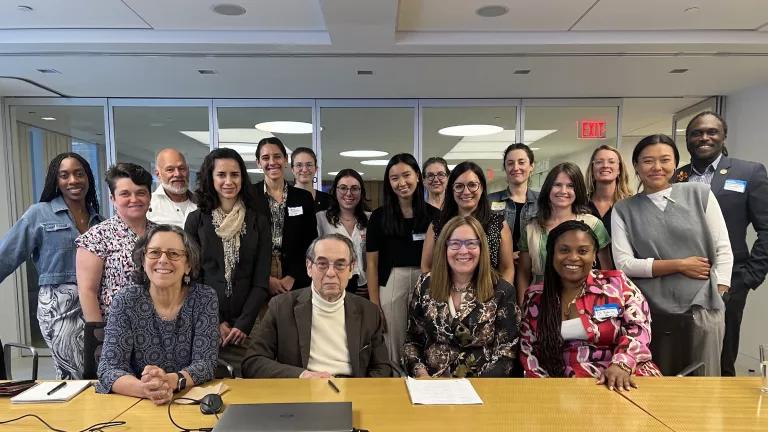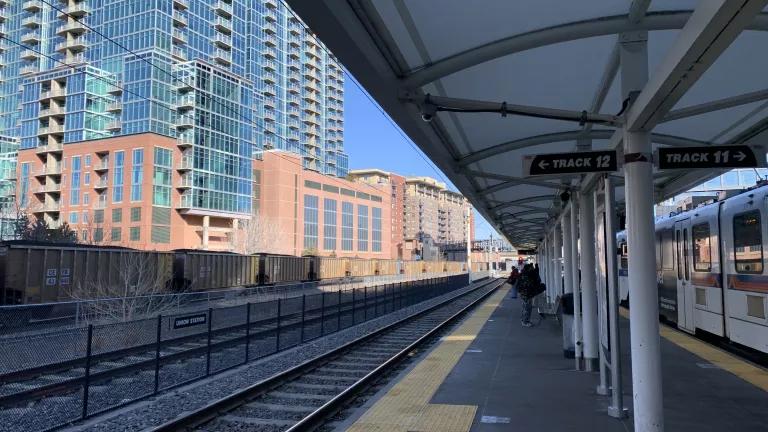Affordable Housing Briefing Featuring Dan Solomon
Discriminatory and exclusionary policies have led to deep disparities in housing for marginalized communities throughout the United States. Architect Dan Solomon explains how improved building policies can lead to housing justice.

NRDC staff joined by architect and urban designer Dan Solomon
Courtesy of Dr. Sabrina Johnson
Discriminatory and exclusionary policies at local, state, and federal levels have led to disparities in housing conditions for systemically marginalized communities throughout the United States. Examples of these practices include redlining of neighborhoods, racial housing covenants, predatory lending for prospective Black and Latine homeowners, and widespread disinvestment in public and affordable housing, contributing to both quality and supply issues. Housing justice is best defined as the equitable transformation of the institutions and systems that have driven racialized dispossession of land, displacement from homes, and exclusion of communities from access to safety and stability. (Othering & Belonging Institute, 2023; Urban Institute, 2023)
On June 5, 2023, NRDC hosted the first in a series of housing justice briefings to honor the work of Dan Solomon, an architect and urban designer whose 50-year career combines achievements in professional practice with academic teachings and writings that center housing justice. Dan has spent his career building affordable housing units. And with this expertise, he has also studied the quality of buildings and their building codes and the quality of life in under-represented demographics.
Examining Dan’s career in this moment of federal investment highlights how federal investment in affordable housing is necessary—and not enough. A holistic approach that centers justice, safety, stability, and health is vital. Dan has spent his career designing affordable multifamily housing and exploring the connection between quality of life and new buildings. When left to its own devices, the built environment does not automatically create great designs. As described by Dan, the building standards in low-income communities do not uphold the dignity of one’s quality of life because the building codes do not always reflect safe and secure housing stock.
Broader policy solutions include the U.S. Department of Housing and Urban Development’s (HUD) Affirmatively Furthering Fair Housing (AFFH) rule, which models ways to achieve equity in access to housing. The AFFH, created in 2015, was part of the Fair Housing Act of 1968, which prohibited discrimination in the sale, rental, and financing of dwellings. The AFFH requires HUD to go beyond simple discriminatory practices and mandates to take meaningful steps toward meeting the FHA’s objectives, such as community desegregation (HUD) (U.S. Department of Housing and Urban Development, 2021). Thankfully, the current Biden administration introduced a new rulemaking in 2023 that seeks to take actions to “overcome patterns of segregation, promote fair housing choice, eliminate disparities in opportunities, and foster inclusive communities free from discrimination.” (U.S. Department of Housing and Urban Development, 2023)
On June 5, we took a moment to convene more than 30 stakeholders from multiple sectors, all of which advocate for safer and more affordable housing, and we reached more than 25 virtual participants from various internal teams who support creating more sustainable housing. The inspiration behind this event stemmed from so many of us advocating for affordable housing that equally serves the most marginalized communities, predominately low-income people of color, with a disproportionate impact on low-income Black residents. We recognize that our current tools do not serve people in vulnerable communities equally.
During the briefing, we engaged in a meaningful conversation that delved into Dan's studies and deepened our expertise in the connection between building codes, building qualities, and their effects on one's quality of life. The conversation was meaningful in advancing our current advocacy efforts.

Dan Solomon and Dr. Sabrina Johnson photographed at HUD headquarters
Courtesy of Dr. Sabrina Johnson
After our affordable housing briefing, NRDC’s chief climate strategist Shelley Poticha, Dan, and I participated in an urgent conversation with HUD's Policy Development & Research and Community Planning & Development staff to discuss Dan's work and ways to create safer affordable housing in urban communities. The goals of the meeting were to educate HUD staff on his studies around the quality of buildings and their impacts on quality of life, as as well as to connect Dan with teams working on zoning codes and local incentives for affordable housing. These insights were key, as they directly related to our recommendations for HUD’s Green and Resilient Retrofit Program (outlined in my previous blog “Housing Advocates on the Green and Resilient Retrofit Program”), which connected community-based insights with informing federal advocacy and strategic priorities. We look forward to the opportunity of working with the agency to implement the recommendations described in NRDC’s submitted comments. Dan's work inspires us, and we will continue to document and record the expertise and lived experience of practitioners from multiple sectors.
Thank you, Dan, for enlightening us!




